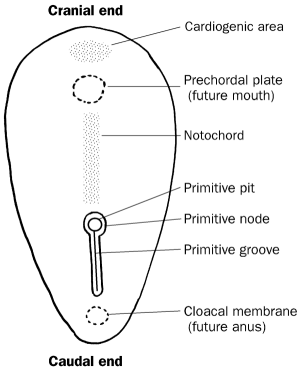|
Gastrulation is the conversion of the epiblast from a
bilaminar disc into a trilaminar
embryonic disc consisting of ectoderm,
mesoderm, and endoderm. Gastrulation begins with the formation of the primitive
streak.
The primitive
streak is a linear band of thickened
epiblast that first appears at the caudal
end of the embryo and grows cranially.
At the cranial end its cells proliferate to form the primitive
knot (primitive node).
With the appearance of the primitive streak it is possible to distinguish
cranial (primitive knot) and caudal (primitive streak) ends of the embryo.
 
Figure 3
- Primitive streak and notochord
Mesenchymal
cells migrate from the primitive knot to form a midline cellular cord known as
the notochordal process.
The notochordal process grows cranially until it reaches the prechordal
plate, the future site of the mouth.
In this area the ectoderm is attached directly to the endoderm without
intervening mesoderm. This area is
known as the oropharyngeal membrane,
and it will break down to become the mouth.
At the other end of the primitive streak the ectoderm is also fused
directly to the endoderm; this is known as the cloacal
membrane (proctodeum), or
primordial anus.
The notochord is
a cellular chord that develops by transformation of the notochordal process.
The notochord will eventually become the nucleus
pulposis of each intervertebral disk.
Germ layers
The embryonic three germ layers give rise to the many
tissues and organs of the embryo:
Table 6
- Embryonic Germ Layers and Their Adult Derivatives
|
Germ Layer
|
Adult Derivatives
|
|
Ectoderm
|
Surface ectoderm
|
Lens of eye
Adenohypophysis (anterior pituitary gland)
Utricle, semicircular ducts, and vestibular
ganglion of CN VIII
Epithelial lining of external auditory meatus
Olfactory placode, including CN I
Epithelial lining of: anterior two thirds of
tongue, the hard palate, sides of the mouth, ameloblasts, and parotid
glands and ducts
Mammary glands
Epithelial lining of lower anal canal
Epithelial lining of distal penile urethra
Epidermis, hair, nails, sweat and cutaneous
sebaceous glands
|
|
|
Neuroectoderm
|
All neurons within the CNS
All glial (supporting) cells within the CNS
Retina
Pineal gland
Neurohypophysis (posterior pituitary gland)
|
|
|
Neural crest
|
Postganglionic sympathetic neurons within the
sympathetic chain ganglia and prevertebral ganglia
Postganglionic parasympathetic neurons within
the ciliary, pterygopalatine, submandibular, otic, enteric ganglia, and
ganglia of the abdominal and pelvic cavities
Sensory neurons within the dorsal root
ganglia, Schwann cells
Pia mater and arachnoid membrane
Chromaffin cells of the adrenal medulla
Melanocytes
Bony structures of the face and neck: Maxilla,
zygomatic bone, palatine bone, vomer, mandible, hard palate, incus,
malleus, stapes, sphenomandibular ligament, styloid process, stylohyoid
ligament, hyoid bone, frontal bone, parietal bond, sphenoid bone, and
ethmoid bone
Odontoblasts
Aorticopulmonary septum
Parafollicular cells of thyroid
Dilator and sphincter pupillae muscles
Ciliary muscle
Carotid body
|
|
Mesoderm
|
Paraxial mesoderm
|
Skeletal muscles of trunk
Skeletal muscles of limbs
Skeletal muscles of head and neck
Extraocular muscles
Intrinsic muscles of tongue
Vertebrae and ribs
Cranial bone
Dermis
Dura mater
|
|
|
Intermediate mesoderm
|
Kidneys
Testes and ovaries
Genital ducts and accessory sex glands
|
|
|
Lateral mesoderm
|
Sternum, clavicle, scapula, pelvis, and bones
of the limbs
Serous membranes of body cavities
Lamina propria, muscularis mucosae, submucosa,
muscularis externae, and adventitia of the gastrointestinal tract
Blood cells, microglia, Kupffer cells
Cardiovascular system
Lymphatic system
Spleen
Suprarenal cortex
Laryngeal cartilages
|
|
Endoderm
|
|
Epithelial lining of the auditory tube and
middle ear cavity
Epithelial lining of the posterior third of
the tongue, floor of the mouth, palatoglossal and palatopharyngeal folds,
soft palate, crypts of the palatine tonsil, and sublingual and
submandibular glands and ducts
Principal and oxyphil cells of the parathyroid
glands
Epithelial reticular cells and thymic
corpuscles
Thyroid follicular cells
Epithelial lining and glands of the trachea,
bronchi, and lungs
Epithelial lining of the gastrointestinal
tract
Hepatocytes and epithelial lining of the
biliary tree
Acinar cells, islet cells, and the epithelial
lining of the pancreatic ducts
Epithelial lining of the urinary bladder
Epithelial lining of the vagina
Epithelial lining of the female urethra and
most of the male urethra
|
As the notochord and neural tube form, the
mesoderm alongside them forms longitudinal columns called paraxial mesoderm. These
columns divide into paired cubical bodies called somites. The somites
develop in pairs; the first pair develops near the cranial end of the notochord
around the end of the third week. Additional
pairs of somites develop in a caudal direction from days 20 to 30 (period
of somite development) and the number of somites is sometimes used as a
criterion for determining an embryo’s age.
The somites give rise to most of the axial skeleton (vertebral column,
ribs, sternum, and skull base) and associated musculature, as well as to the
adjacent dermis.
|

